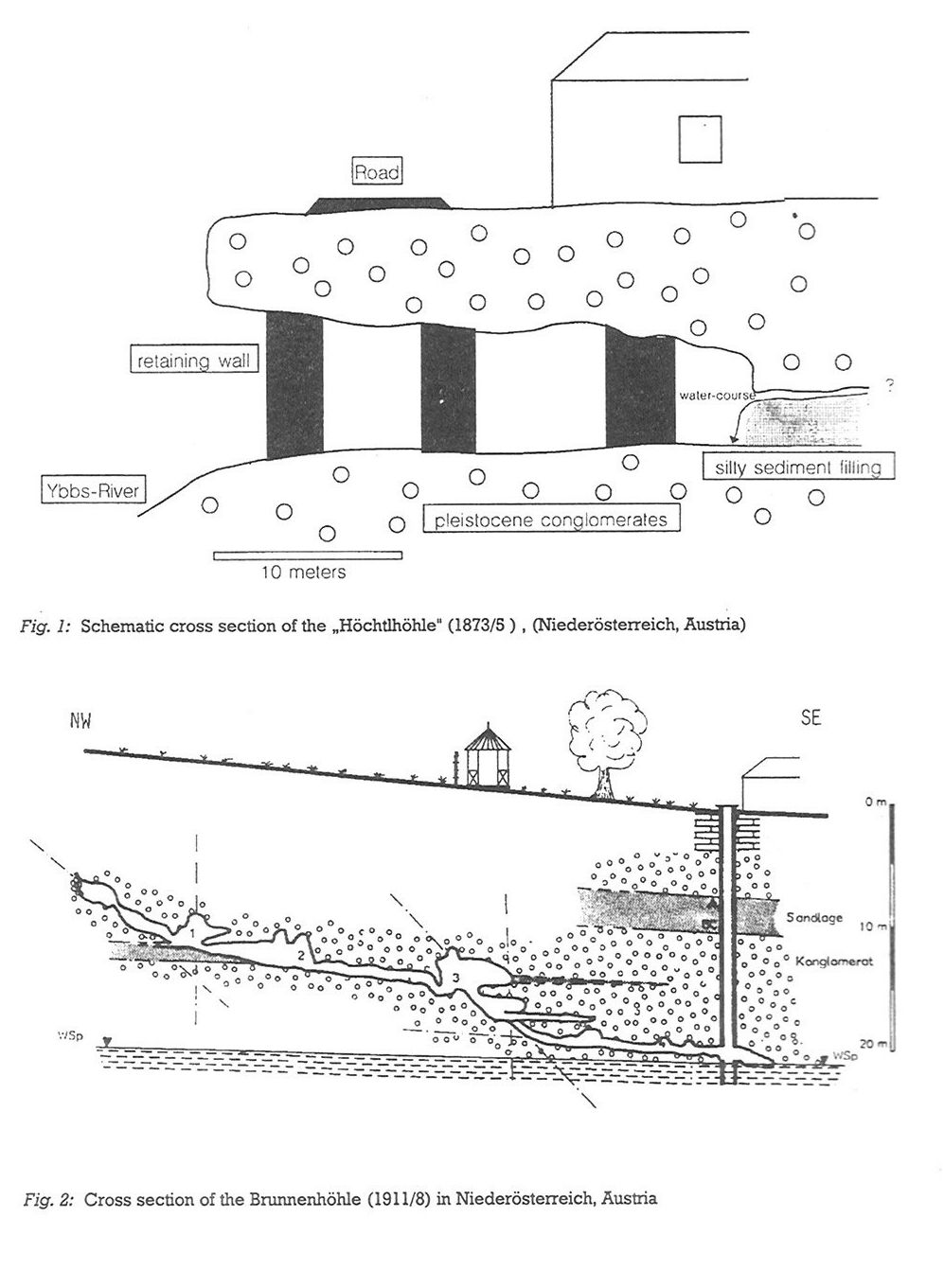MAIS, Karl & PAVUZA Rudolf
Természettudományi Múzeum Karszt- és Barlangtani Osztály, Bécs - Ausztria
Natural Historical Museum, Vienna - Austria
Barlangok Ausztria beépített területein-néhány példával
Caves in urban areas of Austria - a brief overview / Höhlen in verbauten Gebieten Österreichs-einige Beispiele
Beépített területeken ill. alatt Ausztriában a geológiai adottságok miatt nem nagyon sok barlang található. Néhány jellegzetesebbet mutatunk be közülük.
Alsó-Ausztria nyugati részén, az Alpok északi peremén, az Ybbs menti Waidhofen mellett messzirő1 látható barlang, a Höchtl-barlang található a pleisztocénkori megszilárdult teraszkavicsban. Családi házas települes alatt húzódik és csak néhány méter réteg fedi. Keletkezése egyrészt az Ybbs folyó laterális eróziójával kapcsolatos, mely a kereken 50 m széles és 20 m mély völgyet évszázadokon át újra es újra szinte teljesen elöntötte (történelmi festmények bizonyítják). Másrészt a nagyméretű barlangnak van egy szűk folytatása, melyből kis barlangi patak tor elő. Gyenge huzat is erezhető. A talaj itt finomszemcséjű hordalék, mely a céziumizotóp-vizsgálatok szerint csak néhány éves.
Bécstől délre, Bad Voslau térségében, a Bécsi-medence peremének harmadkori konglomerátumában a múlt századi kútásás közben barlangra bukkantak, mely következésképpen a Kút-barlang nevet kapta. A kútaknától enyhen emelkedve és a felszín lejtőszögével megegyezően 20 m mélységig és kereken 60 m távolságig húzódik az Alpok keleti peremének irányában. Felette kertes házas terület van. Talajcseppköves kormeghatározása 124.000 éves értéket adott, a stabil C-13 és C-18 vizsgálata va1őszínű enyhe termális hatásra utalt. Emellett szól az is, hogy a kút vize kb. 2 C fokkal magasabb az eves középhőmérséklethez viszonyítva.
Salzburg déli városrészében - részben csak parkológarázsokon át elérhetően - található néhány kisebb barlang konglomerátumban, részben (pl. a Mönchsbergi-cseppkőbarlang) gazdag cseppkő-dísszel. A 19. században még idegenvezetés is volt itt.
In Austria there are few but remarkable examples of caves in urban areas. The Brunnenhöhle" south of Vienna was found accidently when excavating a well. A cave in the steep flanks of the Ybbs-River valley, the Höchtlhöhle" is' not only of fluviatile origin, but has a narrow connection to a canyon system built up in salty sediments filling up a passage in the conglomerate almost entirely. Geotechnical measurements were necessary to ensure the safety of the houses above the cave. In the city of Salzburg the "Mönchsberghöhlen" were found during the construction of subsurface parking lots. Other examples include a subsurface quarry near the town of Linz, a cave connected to springs in the thermal areas south of Vienna, and small caves in the Austrian capital itself.
In the southern part of the city of Salzburg several small caves, some of them with remarkable dripstone formations, can be reached from subsurface parking lots. In the last century one of these caves, the "Mönchsberg Tropfsteinhbhle" (1352/1) became a show cave for a while
In the western part of the province of Niederösterreich the Ybbs-River has cut steep flanks into Pleistocene conglomerates. Numerous caves have been formed by the river, which flooded the valley occasionally up to 20 meters. This can be seen e.g. on paintings from the turn of the century (City Museum of Waidhofen/Ybbs). As the houses of the city of Waidhofen were built quite close to the edge of the river valley they obviously overly these caves. Some years ago, geotechnical measures became essential to the safety of the house owners and retaining walls had to be built in some of the caves changing the natural state of the caves entirely. In the .Hochtlhohle" (No. 1873/5 of the Austrian cave register) a sedimentary sequence was found during the works leading to a very narrow passage. It was carefully explored because of tiny dripstones for about ten meters. Those silty sediments filled a larger passage in the pleistocene conglomerates almost entirely. A "canyon" within the silty sediments seems to be rather young due to higher levels of (Czernobyl)-Caesium- contents.
Near the city of Linz (Oberosterreich) a narrow natural passage leads to a large, extended subsurface quarry with a surveyed length of about one kilometer, named "Steyreggerhöhle" (6843/1). This "cave" was heavily used during World War II. Recent measurements of Radon and CO2 fielded very high values (about 20 000 Bq/m3 resp. > 3000 ppm). At the time of the utilisation, these values were certainly lower due to additional (now vanished) entrances to this quarry.
Situated in the vicinity of the thermal spa of Bad Fischau (Southern Vienna Basin, Niederösterreich) the "Fischerhöhle" (1864/5) is a rather odd example of a cave used as a temporary living room.
Finally the two and only small caves in Vienna-named Probushöhle" (1917/2) and "Severinushöhle" (1917/1)-are worth mentioning despite the fact that both are artificial to some extent. They were used as storage and (probably) living rooms in the past, but today they are nearly forgotten.

